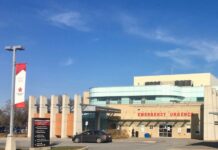The cyber security “incident” at KDH last week may mean that North Grenville has become the latest victim of a growing problem that is affecting medical facilities around the world. While the precise nature of the KDH incident is still unclear, and the OPP continue their investigation, it does seem to fit into a pattern that has become all too common. It seems that people have found yet another way to abuse and misuse technology to cause confusion and make money.
In June of this year, the CBC reported that “Canada’s health system is under siege from unrelenting cybercriminals trying to access patient information and other data, according to health-care professionals and cybersecurity experts who say hospitals and clinics are unable to cope with the growing threats.” In March, the Canadian Centre for Cybersecurity issued an alert warning medical facilities of “the elevated risk faced by health organizations involved in the national response to the COVID-19 pandemic”.
And it isn’t just Canada that has been affected. The Irish health service was hacked by ransomware in May of this year, throwing the entire system into chaos. Reports described the attack as a “major disaster”. In the middle of a pandemic, these attacks are delaying tests and procedures, and may have been responsible for preventable deaths. Ransomware attacks can result in ER downtime, ambulance diversions, and appointment cancellations, and have been described as “one of the biggest threats to the healthcare sector in 2021″.
There is something particularly callous, evil, about attacks of this kind on the health system of countries and provinces at a time when those same healthcare facilities are under extreme pressure trying to deal with a pandemic. These criminals shut down a system, either in a specific hospital, or across an entire national system, and demand enormous sums of money to restore access. If their demands are not met, private patient data can be released on-line, or else records can be completely deleted, leaving medical professionals without patient histories, medication records, or even simply schedules for procedures.
But there is a further danger from these attacks, and it’s one that residents here need to be on guard against. The patient data collected by these attacks can then be used by scammers, who will contact the individual patient, using the information they stole, and try to extort money or other information from the victims.
Much of the hacking activities carried on these days is basic espionage, especially during the pandemic, as other corporations, governments, or criminal gangs, attempt to steal medical research, or agricultural and industrial technology. It is a strange and disturbing phenomenon that there is a “dark web” on which so much illegal and dangerous activity is carried out, largely unseen and unknown.
Many times, in these pages, we have warned residents of the dangers that exist on-line. Hacking, phishing, trolling, and so many other terms have been coined to describe on-line behaviour. Ransomware is not only directed at institutions, it can be used against private businesses, even individuals, where demands for payment is made if the victim wants to regain access to their data and files.
Data breaches have caused many banks, insurance companies, or credit card corporations to issue warnings to clients that their personal information has been stolen. This can include their name, address, credit card numbers, social insurance numbers, or other information useful to criminals.
For example, the American Osteopathic Association informed their clients in 2020 of an incident that impacted 27,485 individuals. Addresses, names, birth dates, Social Security numbers, financial account information, email addresses, usernames, and passwords were included in the stolen data.
Whether the cyber security incident at KDH is part of this general pattern remains to be seen, but other Canadian medical facilities have experienced attacks in the past year. According to reports, “the malware, known as “Ryuk,” attacks computer networks but remains invisible to average users for weeks or months. During that time, it collects information about the organization and its perceived ability to pay a ransom. Ryuk then locks files, demanding the network owner pay a sum of money to make them accessible again.” In the attacks on three Ontario hospitals in 2019, email systems were taken offline, health-care records became harder to access, and patients were warned of longer wait times.
KDH needs our patience as they recover from whatever happened last week. This is not something for which they can be blamed, not a failure on their part. These attacks are taking place against the most secure cybersecurity systems, and no institution, no corporation, no individual, is secure from criminal activities of this kind.
As with so many other aspects of online activity, from Facebook algorithms to cyber bullying of young people, this is the world in which we now live. We need to adapt, and learn how to deal with this new reality.







